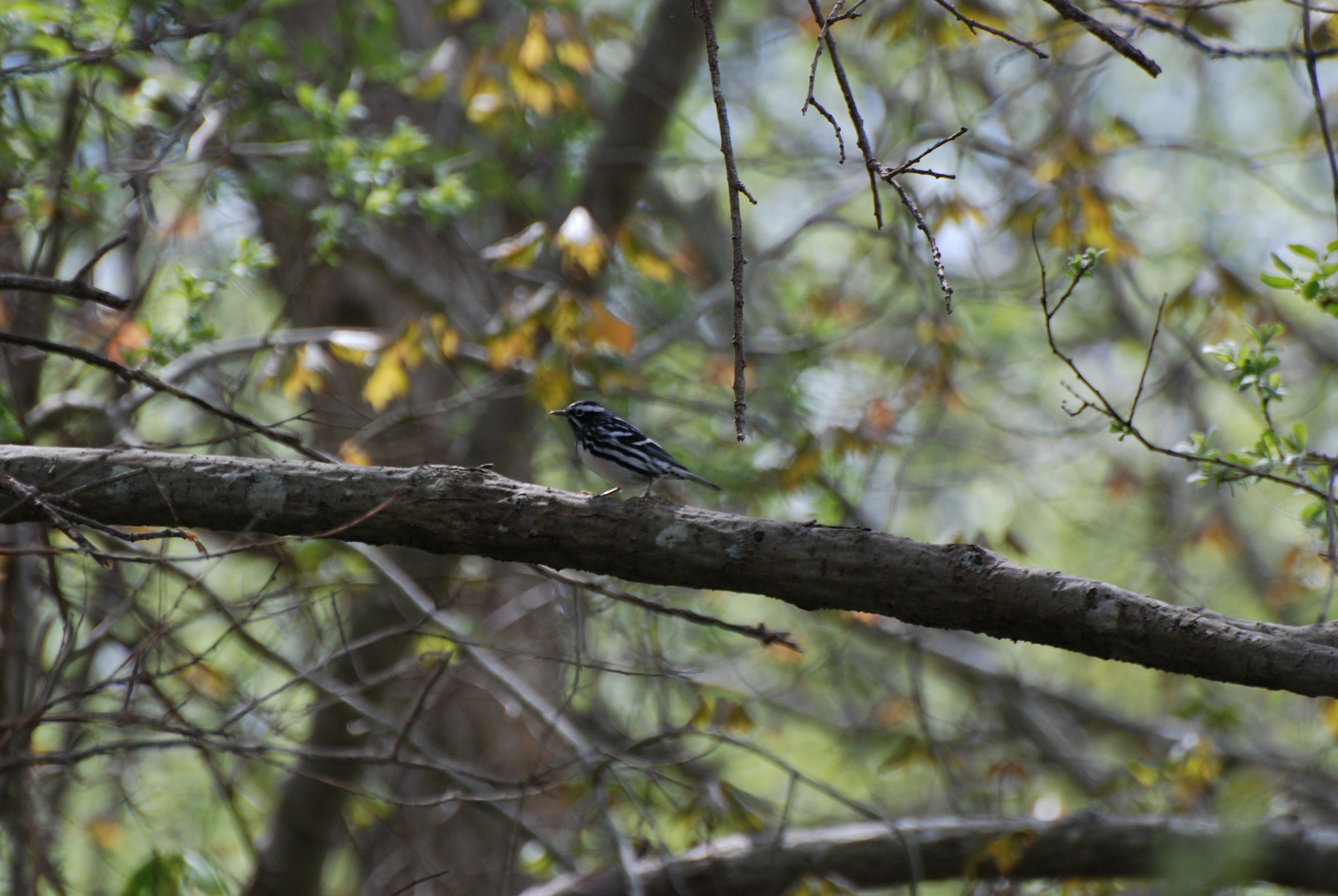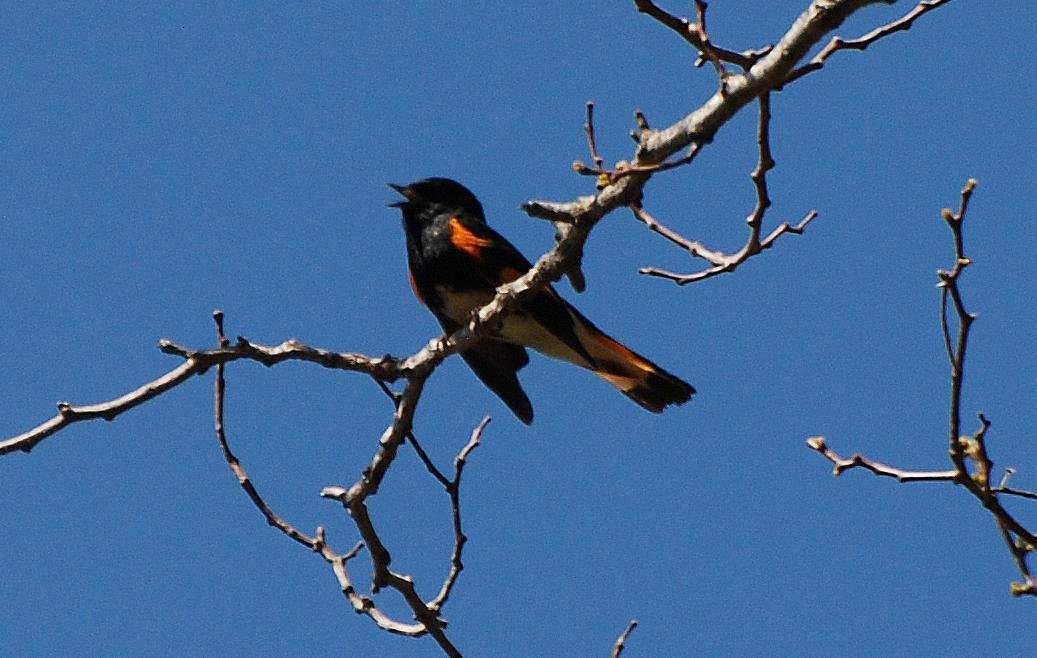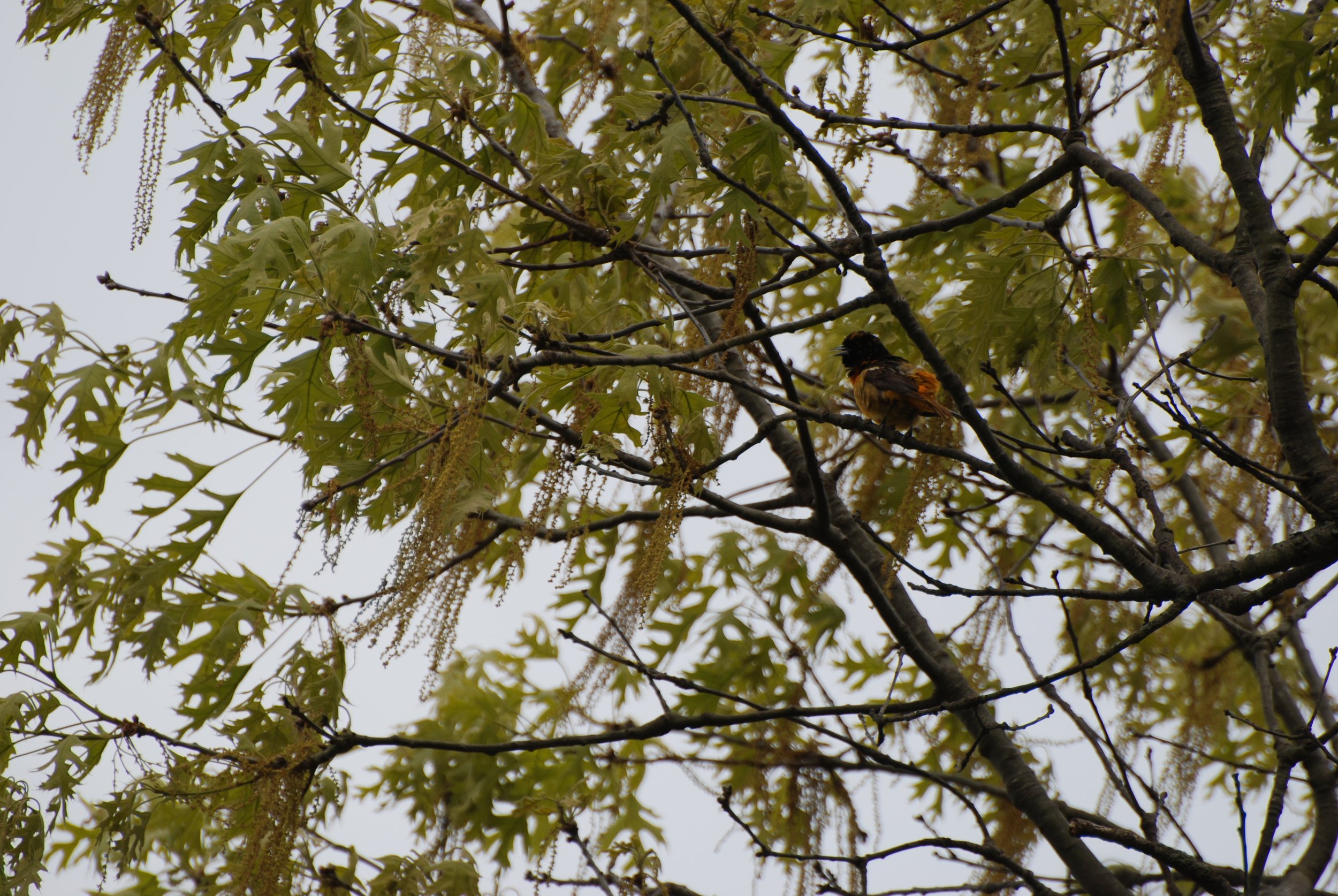As spring approaches, I look forward to another season of bird migration and the jump starting of the cycle of life it symbolizes. Fall and spring are catalysts in the life cycles of plants and animals that share the environment with us. One of the most impressive events that occurs during the change of seasons is bird migration. But, now, I am thinking of a mid-September morning not too long ago, when I met up with friend and Fire Islander, Dave Burns, on a local birding expedition at Sunken Forest, a globally rare ecological community that lies in the heart of Sailors Haven on Fire Island.

Black and White Warbler
As one of four barrier islands on the south shore of Long Island, it is just one migratory bird stop among many along the greater Atlantic Flyway, a broad swath of land and water stretching from Greenland to the southern hemisphere. Along this pathway many bird species take respite and replenish their energy stores on the abundant food sources that Sunken Forest and other areas of Fire Island provide as they make their way to the southern U.S., Caribbean, or South America.
Our expectation was high as the weather forecast of northerly winds the night before held the promise of a “fallout,” or the arrival of many migrants on a favorable wind stream. Few clouds were present, temperatures were mild, and winds were light. These conditions were similar to a fall migration outing on Fire Island I took some 40 years ago that cemented my interest in ornithology and the pastime of birding. While visiting Democrat Point on the western end of the island, I stumbled upon a snowy owl, a medium sized owl with white plumage that is endemic to northern latitudes, as he was taking shelter under a stranded wooden boat hull. It was equally startled by me and quickly flew off into the nearby dunes, eventually finding a perch atop a cedar snag. I spent the remainder of my time there observing him from afar. But it was at that point the hook was set and I was drawn to spend more time birding there and elsewhere along the coast.
We boarded Dave’s Carolina skiff near Captree Island, making our way out of the protected berth into the State Boat channel and then south and eastward toward the Fire Island coastline, which contains a mosaic of residential communities interspersed with undeveloped natural areas. Since 1964, the National Park Service has owned and managed a number of these undeveloped parcels stretching from the Lighthouse to its Smith Point Wilderness Area Visitor Center in the east, including our destination, Sunken Forest. As we motored along the shoreline, I imagined we would have a good day of birding, but I was aware of the many bird species that are in deep trouble according to a report published in the journal Science, which documented the loss of nearly 3 billion birds across North America since 1970 (see Decline of the North American avifauna | Science). As noted in the article, many of the declining species are fairly common such as blue jays and Baltimore orioles, illustrating the struggle even common species are having across the continent.
Ironically, while anthropogenic activities have played a huge role in the decline of birds (and sometimes extinction) through modification and destruction of habitat and other causes, humans have revered and been fascinated by our feathered friends since time immemorial, and have enacted laws to protect them. We studied birds and held them as sources of artistic inspiration. They served as spiritual guides and companions, messengers, symbols of strength, and aids to agriculture as natural pollinators. Well before the Greek playwrights and philosophers weaved birds into their literary works and philosophical musings, paleolithic peoples drew their likeness on cave walls around the world. In more modern times birds, or avifavuna, captured the imagination and study of John James Audubon (1785-1851), who brought to life about 500 species in paintings and drawings of specimens that he collected in his travels in the eastern half of the country and included in his 1824 first book, “Birds of America.” As a young naturalist circumnavigating the globe aboard the HMS Beagle, Charles Darwin (1809-1882) studied the finch species of the Galapagos and Cocos Islands, from which arose his theories of island speciation and natural selection. Overall, he collected about 1,500 species of birds on his five-year trip, contributing greatly to the burgeoning science of ornithology. Birds were and continue to be inspirations for art, invention, and overall enjoyment – Vincent van Gogh (1853-1890), painted “Kingfisher by the Waterside” in 1887 and early inventors studied their form and function in man’s quest for flight. Lastly, it’s no wonder that a 2011 survey by the U.S. Fish and Wildlife Service showed that over 3 million New Yorkers participate in bird watching every year (see 2011 National Survey of Fishing, Hunting, and Wildlife-Associated Recreation (census.gov)).
As mid-morning approached, we traded the sounds of the loud whirr of the outboard motor for the quiet of the island as Dave pulled back on the engine’s throttle as we puttered up to the Sailors Haven dock. During the summer, Sailors Haven is a popular destination, but now the marina was virtually empty. With the boat secured, we headed toward the trailhead near the visitor’s center.
If you were to draw a line from the bay to the ocean at Sailors Haven you will likely encounter a habitat complex comprised of sand flats, bay beach, saltmarsh, scrub-shrub, forest, dunes, and ocean sandy beach. This physical arrangement of habitats contributes to the overall biodiversity of Sailors Haven, as different habitats attract and are used by different plant and animal species. Sailors Haven is flanked by the communities of Cherry Grove to the east and Point O’Woods to the west. It’s easy to envision that Sailors Haven thus serves as a refugia for birds, plants, and other wildlife, where more sensitive species can be relatively protected from human disturbance where development and day to day activities can impair wildlife behaviors.

American redstart
As we neared the trail head to the Forest, I am always struck by both the fragility and stability of Fire Island. On the one hand, the ever-increasing erosion on the bay shoreline has been gnawing at the narrow bay beach and the northern edge of the Sunken Forest for quite some time. On the other hand, Sunken Forest, nestled or ‘sunken’ behind some impressive primary and secondary dunes (a feature that inspired its name) took root some 300 years ago and largely persists to this day, lending a sense of stability on the dynamic barrier island.
In a matter of steps, we walked into the dense forest canopy created by the evergreen holly, sassafras, shadbush, black cherry, red cedar, red maple, pitch pine, and oak trees. The bird breeding season had long passed, so songbirds were not singing to establish territories and attract mates. Consequently, we relied mostly on visual cues for identification, watching for movements along the treetops, shrubs, and ground.
Sunlight flickered on the forest floor where there were breaks in the leafy canopy. Moving quickly and inconspicuously through the vegetation, ruby and golden crowned kinglets, two species of our smallest songbirds on Long Island, caught insects in flight and then quickly retreated to their leafy perches. Their olive-green plumage providing an excellent camouflage against the grey-green holly tree branches from predators such as merlins, a bird of prey, which course through the forest on silent wings in search of small birds. Further along, yellow-rumped warblers moved in small flocks like marauders as they muscled their way deeper into the understory vegetation in search of insect prey which were invisible to us. In the fall, the plumage of these birds is varied, but the yellow patch on its rump is a dead giveaway all year round. Almost simultaneously, the call of an eastern towhee, a stout, handsome tri-colored bird sporting black, rufous brown, and white, alerts us to his presence. He is kicking up leaves in search of insects or seeds on the forest floor. As we press on, more birds appear and our list grows: American redstart, goldfinch, catbird, cardinal, brown thrasher, and on.
Eventually, the trail reaches an observation deck above the forest canopy. The tree line is tight and sculpted by the salty air and appears knitted to the surrounding landscape. We trained our binoculars on flocks of sanderlings and sandpipers, which are often mistaken for the solitary piping plover, as they retreat and advance in the ocean intertidal zone in search of marine crustaceans and worms. Greater black-backed gulls, our largest gull species on Long Island, lumber on the beach stopping to feast on ocean clams tossed up on the beach by the waves. Flocks of black scoters bob in the ocean just beyond the breaker zone diving for small mollusks and fish on the nearshore ocean floor. A little further out, northern gannets, graceful elongate seabirds, soar high above the ocean, periodically taking precipitous dives to strike their fish prey with precision. Their white bodies and black wing tips along with their trademark aerial tactics are quick giveaways to identifying this visitor that hails from the North Atlantic.
On our return walk to the bayside, tree and barn swallows swoop over and beside us as they snatch insects over the saltmarshes. As we board the boat, I notice an osprey conspicuously hovering over the bay before it folds its wings and enters a rapid decent towards the water, its talons eventually securing the catch. A solitary common loon in non-breeding plumage, surfaces now and then between dives for small fish off Ocean Beach as we slowly motor along the shoreline on our way back to Captree. A little while later, a shaggy headed belted kingfisher, a blue jay-sized bird with a heavy, straight bill, and our only passerine species that hunts for fish, is perched on a snag in between his foraging attempts on the schools of small fish in the bay. Having returned to the dock, a male northern harrier, tipped its wings left and right and disappeared occasionally as it flew over the marsh in pursuit of voles or field mice.
Back home on the mainland, I contemplated the day’s “haul” and checked in with Dave on his notes. All told, we were rewarded with a variety of birds, and I was thankful that places like Sailors Haven a stone’s throw from a sea of humanity, can offer a sense of wildness. But, clearly not all bird populations are faring well and more needs to be done to reverse some of the ominous trends pointed out in the Science article.

Baltimore Oriole
So, what can be done? On a planet-wide scale, the late biologist E.O. Wilson, PhD warned about mass extinction and the collapse of biodiversity in his book, “Half Earth – Our Planet’s Fight for Life.” The E.O. Wilson Biodiversity Foundation ultimately spearheaded the Half-Earth project, promoting preservation of the world’s biodiversity through protection of the half the world’s terrestrial, and aquatic and marine environments. Doug Tallamy, PhD, professor of Wildlife Ecology at the University of Delaware, promotes an individualistic approach (see www.Homegrownnationalpark.org) where homeowners contribute to the rebuilding of biodiversity through native plantings that support the insects, food, and habitat structure which form the base of the food chain and support wildlife. With enough participating landowners, the combined effect could approach landscape levels and provide meaningful ecological uplift to various wildlife species and their habitats. For my part, we try to use native plants around our property when we can, install nest boxes up for cavity nesters like chickadees, screech owls, and wrens, and get involved with neighbors on local land preservation efforts.
Well, northern cardinals are starting to sing so I hope to visit the island over the next couple of months as Spring migration gets in full swing for some more birding and to update you on what I saw. Or, better yet, hit the trails and see for yourself!
Steve Papa is a a wildlife biologist with the US Fish and Wildlife Service. Raised in Bay Shore and presently living in Blue Point for the past 30 years, the views presented in this essay are his own.































